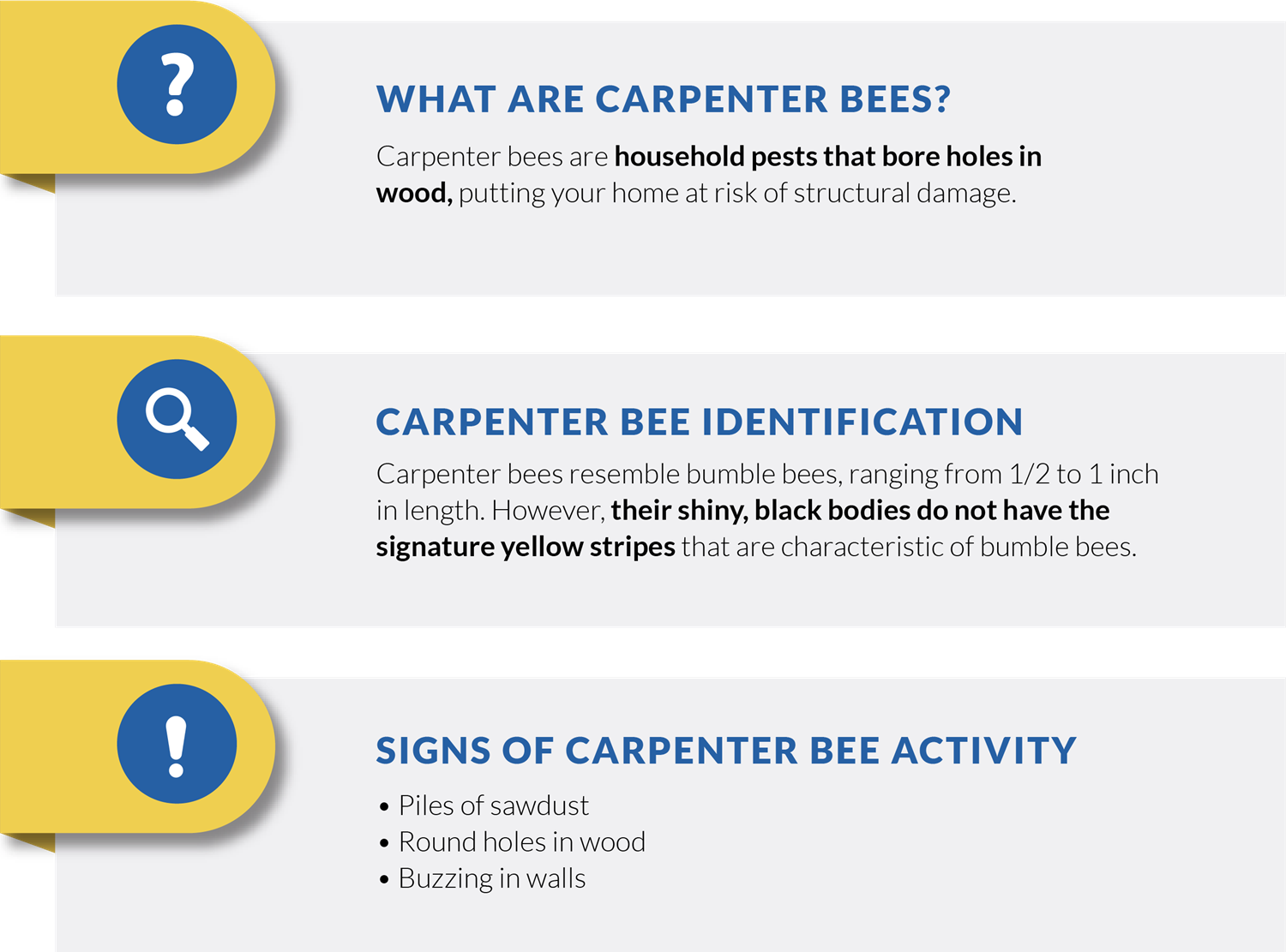Apr 22, 2019

The sight of a bee or multiple bees buzzing around your home can be very alarming, especially if you’re unable to determine where they’re coming from. During the summer, it’s possible that bees have been able to sneak into your home through an open door, window, or a broken screen. It’s important to know what type of bee you’re dealing with before brushing off the pest sighting as a one-time occurrence — especially if you’re sharing your home with carpenter bees.
Carpenter Bee FAQs
If left untreated, a carpenter bee infestation can cause serious problems for homeowners. Here’s everything you need to know about carpenter bees:
What are carpenter bees?
Carpenter bees are common household pests that get their name from their habit of boring holes in wood. The tunnels these bees create within wooden structures are used as nesting grounds for the females to lay eggs. Unlike bumble bees that live in colonies, carpenter bees are solitary insects, each building their own individual nest.
What do carpenter bees look like?
Carpenter bees are similar in size and shape to bumble bees. However, carpenter bees lack yellow markings on their bodies. Carpenter bees have shiny, black abdomens while bumble bees have hairy, yellow and black abdomens.
Do carpenter bees sting?
Male carpenter bees cannot sting, although they can be aggressive when it comes to protecting their nests. Male carpenter bees are known for charging toward perceived predators using a dive-bomb attack technique, which is essentially harmless, but can be intimidating due to the large size of the bee and its loud buzz.
Unlike their male counterparts, female carpenter bees do have a stingers. Fortunately, female carpenter bees rarely sting unless their nests are threatened.
Are carpenter bees dangerous?
While carpenter bees themselves are not likely to cause harm to your or your family, they do pose a threat to your home. Just like termites, carpenter bees burrow into wood, creating tunnels that can weaken many important structures in your home. If carpenter bee damage becomes severe enough, your family’s safety could be at risk.
Signs of Carpenter Bees
Since carpenter bees are not social insects, they don’t travel in swarms or colonies. Carpenter bee damage occurs slowly over time and is usually too subtle for homeowners to notice until the damage becomes significant, so it’s very important to know the signs of a carpenter bee infestation and act quickly to fix the problem.
Look out for these five common signs of carpenter bees in your home:
Insect Presence
If you start to see bees buzzing around your home, be sure to take note of what they look like and where you find them. Carpenter bees are often mistaken for bumble bees, however, carpenter bees lack bumble bees’ signature yellow stripes. Carpenter bees are attracted to wood, particularly raw wood. If you see bees congregating near your roofline, under your porch, or around any unfinished wooden structures in basements, attics or crawl spaces, you’re likely dealing with carpenter bees.
Buzzing in Walls
Carpenter bees bore holes in wood in order to build tunnels for nesting. As the bees are drilling through wooden surfaces in your home, you may be able to hear a buzzing or vibration sound coming from within your walls. If you hear strange sounds coming from your walls and are unsure of the cause, be sure to call a pest control specialist. Other household pests such as termites and carpenter ants could also be responsible for the noises.
Piles of Sawdust
When carpenter bees drill into wood, they leave behind frass, which is essentially sawdust. Frass often appears in piles below the site where the holes have been created. You might also find frass clinging to door and window frames or other surfaces close to the bees’ tunnels. Frass is also a common byproduct of termite activity, so it’s best to call a professional if you notice any frass in your home.
Read more: How to Recognize the Signs of Termite Damage
Round, Smooth Holes in Wood
One of the most distinct signs of carpenter bee activity is the shape of the holes they bore. Carpenter bees create smooth, nearly perfectly circular holes that are large enough for their bodies to fit through. These holes are very unique compared to the damage created by other types of wood-boring insects.
Structural Damage
Over time, carpenter bees can cause significant damage to wooden structures around your home, including wooden stairs, railings, decks and porches. If anything begins to warp or crack, check for holes or tunnels in the damaged wood.
How to Eliminate Carpenter Bees
Carpenter bees can be difficult to get rid of once they’ve started building tunnels within your home. Although they’re unlikely to harm you, they are fiercely protective of their nests.
Contact CroppMetcalfe to help you get rid of your carpenter bee problem. Our 5-Star Technicians are trained to safely remove carpenter bees from your home and assess any damage that’s been caused by the infestation. Call 703-698-8855 or schedule an appointment online today.